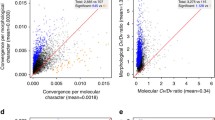Summary
In order to clarify some controverisal phylogenies such as those regarding the triplet of human, rodent, and cow and the evolutionary position of Lagompopha with respect to other mammals, we have analyzed both nuclear and mitochondrial genes using the stationary Markov model developed in our laboratory. We found that the two sets of genes give different results. In particular the mitochondrial tree showed rabbit linked first to rodents and the the rabbit-rodents branch linked to artiodactyls with human as the outgroup. The most favorite nuclear tree showed human linked first to artiocactlys and the human-artiocactyls branch linked to rabbit with rodents as the outgroup. The obvious questions, (1) which tree is the correct one, or (2) both trees can be incorrect, and (3) how can we explain such an evolutionary pattern, are discussed on the basis of our limited knowledge of factors that influence the clocklike behavior of biological macromolecules.
Similar content being viewed by others
References
Bernardi G, Olofsson B, Filipski J, Zerial M, Salinas J, Cuny G, Meunier-Rotival M, Rodier F (1985) The mosaic genome of warn-Blooded vertebrates. Science 228:953–958
Easteal S (1988) Rate constancy of globin gene evolution in placental mammals. Proc Natl Acad Sci USA 85:7622–7626
Felsenstein J (1990) PHYLIP manual version 3.3. University Herbarium, University of California, Berkeley
Goodman M, Czelusniak J, Beeber JE (1985) Phylogeny of primates and other eutherian orders: a cladistic analysis using amino acids and nucleotide sequence data Cladistics 1:171–185
Gouy M, Gautier C, Attimonelli M, Lanave C, Di Paolo G (1985) ACNUC — a portable retrieval system for nucleic acid sequence databases: logical and physical designs and usage. CABIOS 1:167–172
Higgins DG, Sharp PM (1989) Fastt and sensitive multiple sequence adlignments on a microcomputer. CABIOS 5:151–153
Lanave C, Preparata G, Saccone C, Serio G (1984) A new method for calculating evolutionary substitution rates. J Mol Evol 20:86–93
Li W-H, Wu C-I (1987) Rates of nucleotide substitution are evidently higher in rodents than in man. Mol Biol Vol 4:74–77
Li W-H, Guy M, Sharp PM, O'hUigin C (1990) Molecular phylogeny of Rodentia, Lagomorpha Primates, Artiodactyla, and Carnivora and molecular clocks. Proc Natl Acad Sci USA 87:6703–6707
Long M, Gillespie JH (1991) Codon usage divergence of homologous vertebrate genes and codon usage clock. J Mol Evol 32:6–15
Novacek M (1985) Cranial evidence for rodent affinites. In: Luckett WP, Hartenberger JL (eds) Evolutionary relationships among rodents: a multidisciplinary analysis. Plenum, New York, pp 59–81
Pesole G, Attimonelli M, Liuni S (1988) A backtranslation method based on condon usage strategy. Nucleic Acids Res 16:1715–1728
Preparata G, Saccone C (1987) A simple quantitative model of the molecular clock. J Mol Evol 26:7–15
Saccone C, Pesole G, Preparata G (1989) DNA microenvironments and the molecular clock. J Mol Evol 29:407–411
Saccone C, Lanave C, Pesole G, Preparata G (1990) Influence of base composition on quantitative estimates of gene evolution. Methods Enzymol 183:570–583
Saccone C, Pesole G, Kadenbach B (1991a) Evolutionary analysis of the nucleus-encoded subunits of mammalian cytochrome oxidase. Eur J Biochem 195:151–156
Saccone C, Pesole G, Sbisá E (1991b) The main regulatory region of mammalian mitochondrial DNA: structure-function model and evolutionary pattern. J mol Evol 33:83–91
Shoshani J (1986) Mammalian phylogeny: comparison of morphological and molecular results. Mol Biol Evol 3:222–242
Wilson AC, Cann RL, Carr SM, George M, Gyllensten UB, Helm-Bychowski KM, Higuchi RG, Palumbi SR, Prager EM, Sage RD, Stoneking M (1985) Mitochondrial DNA and two perspectives on evolutionary genetics. Biol J Linn Soc 26:375–400
Author information
Authors and Affiliations
Rights and permissions
About this article
Cite this article
Pesoleo, G., Sbisá, E., Mignotte, F. et al. The branching order of mammuals: Phylogenetic trees inferred from nuclear and mitochrondrial molecular data. J Mol Evol 33, 537–542 (1991). https://doi.org/10.1007/BF02102806
Received:
Revised:
Issue Date:
DOI: https://doi.org/10.1007/BF02102806




